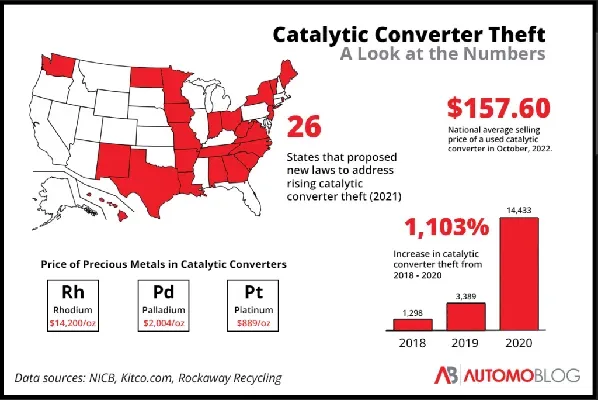Catalytic converter theft has emerged as a pressing concern for vehicle owners across the country, with thieves exploiting the high value of precious metals contained within these vital car components. In recent years, this crime has peaked significantly, prompting urgent calls for vehicle theft prevention measures. The National Automobile Dealers Association (NADA) has highlighted the importance of addressing catalytic converter crime through stricter auto theft legislation, which aims to make stolen converters harder to liquidate. One effective approach being considered is VIN engraving, which would link these stolen parts back to their original vehicles and deter would-be criminals. As awareness of catalytic converter theft grows, it is crucial for car owners to understand their options in protecting their vehicles and contributing to legislative efforts against this alarming trend.
The illicit trade in vehicle exhaust systems, particularly the theft of catalytic converters, represents a significant challenge for modern automobile owners. These vital emissions control devices, often rich in valuable precious metals, have attracted the attention of thieves eager for quick profits. As communities grapple with the ramifications of exhaust system crime, discussions surrounding preventative measures such as VIN stamping are gaining momentum. Legislation aimed at curbing these incidents is gaining traction, with several states leading the charge in implementing effective solutions. By understanding the nuances of vehicle security and legislative evolution, car owners can play an active role in safeguarding their property against the relentless wave of automotive crimes.
Understanding Catalytic Converter Theft in 2023
In 2023, catalytic converter theft continues to be a pressing concern for vehicle owners, despite a notable decline from previous years. The reported thefts witnessed a significant drop from 45,000 claims in 2022 to 21,000 in 2023, signaling legislative efforts are gradually taking effect. However, thieves still target these valuable components because of the precious metals they contain, like platinum, palladium, and rhodium. Understanding the motivations behind these crimes is crucial for vehicle owners to take preventative measures and safeguard their assets.
As awareness around catalytic converter crimes increases, so do the legislative attempts to curb this rampant issue. The introduction of the PART Act—aimed specifically at mandating VIN engraving on catalytic converters—highlights the push towards enhanced vehicle theft prevention strategies. By linking these components directly to vehicles, law enforcement can better trace stolen converters and discourage future thefts, ultimately protecting consumers and deterring criminals from targeting vehicles.
Vehicle Theft Prevention Strategies
Preventing auto theft, including catalytic converter theft, requires a multi-faceted approach. Vehicle owners are encouraged to take proactive steps such as parking in well-lit areas, utilizing motion sensor lights, and installing alarm systems. These strategies not only protect cars against theft but can dramatically reduce the likelihood of thieves targeting vehicles. Furthermore, owners should consider physical barriers like protective cages, engineered specifically to hinder access to the catalytic converter.
Vehicle Identification Number (VIN) engraving is another effective strategy. Engraving the VIN onto the catalytic converter allows for easier tracking if theft occurs, significantly increasing the odds of recovery. Many police departments offer this service at minimal or no cost, underscoring the importance of community involvement in vehicle theft prevention initiatives. Such measures not only empower vehicle owners but also serve to build a more vigilant community.
The Role of Legislation in Combating Catalytic Converter Theft
Legislation plays a critical role in the fight against catalytic converter theft at both state and federal levels. Recent bills introduced in Congress aim to establish a national standard which would streamline efforts to reduce theft and hold offenders accountable. Organizations like the National Automobile Dealers Association (NADA) support these legislative measures, emphasizing the need for legal frameworks to protect consumers and businesses impacted by catalytic converter crimes.
Many states have already taken steps to implement local legislation aimed at decreasing auto theft through better regulation of scrap metal sales, which is often where stolen catalytic converters end up. Stricter laws on selling these parts are essential, serving as a significant deterrent to thieves. By showing a commitment to tackling this issue through comprehensive policy reform, lawmakers can create a safer environment for car owners and reduce the incentive for criminals.
The Impact of NADA’s Endorsement on Legislative Action
The National Automobile Dealers Association (NADA) has been vocal in its support for legislative measures addressing catalytic converter theft, creating a unified front in combating this nationwide problem. NADA CEO Mike Stanton has highlighted the dire implications of these thefts for communities, stressing the necessity for federal action to protect citizens and ensure the safety of vehicles. The endorsement from NADA not only lends credibility to the legislative efforts but also amplifies the call for urgent action from policymakers.
The collaboration between vehicle industry stakeholders and legislators is vital in formulating effective auto theft legislation. NADA’s involvement signifies a recognition of the extensive impact car theft has on both local economies and safety. By advocating for comprehensive solutions, including potential federal grants to support VIN engraving initiatives, the organization aims to bolster protection mechanisms for vehicle owners across the nation.
The Economic Costs of Catalytic Converter Theft
The economic implications of catalytic converter theft are profound, with estimates suggesting that stolen converters can be resold for anywhere between $20 to $350 on the black market. However, the cost of replacing these units for vehicle owners often exceeds $2,500, presenting a financial burden that extends beyond mere inconvenience. Such staggering statistics reveal the urgent need for continued public awareness and protective measures.
Additionally, the spike in catalytic converter crimes directly affects insurance premiums and automotive repair costs, posing broader implications for consumers. The continuous rise in theft rates often translates to increased insurance claims, leading companies to adjust their pricing structures to cover potential losses. Understanding these economic repercussions is essential for vehicle owners to remain vigilant and proactive in combating theft.
VIN Engraving: A Practical Solution to Theft
VIN engraving is emerging as a practical solution in the fight against catalytic converter theft. This process involves stamping the Vehicle Identification Number onto the catalytic converter, creating a clear link between the vehicle and its components. Effective in both preventive measures and recovery efforts, VIN engraving can facilitate easier tracking and identification of stolen parts, significantly increasing the chances of recovery for victims.
Various states have already implemented programs to provide VIN engraving services at no cost or low expense, encouraging vehicle owners to actively participate in safeguarding their cars. As auto theft legislation evolves, support for VIN engraving initiatives will likely play a pivotal role in deterring criminals and making it increasingly difficult to sell stolen converters on the black market.
The Future of Auto Theft Legislation
Looking forward, the future of auto theft legislation appears hopeful with several proactive measures being discussed in Congress. Legislative efforts primarily focus on creating a comprehensive framework that holds thieves accountable and establishes stricter regulations for the sale of used auto parts, including catalytic converters. Such efforts are crucial to ensuring the safety and integrity of personal property.
The dynamics of catalytic converter crimes underline the need for continuous adaptation of laws to meet the evolving challenges posed by criminals. Future legislation will need to prioritize not just punitive measures for offenders but also support preventative strategies like community awareness campaigns alongside VIN engraving initiatives, which are integral in keeping vehicle owners informed and secure.
Public Awareness and Community Engagement
Public awareness and community engagement play a crucial role in combating catalytic converter theft. By informing vehicle owners about the risks associated with catalytic converter crimes and the preventive measures they can take, communities can foster a more vigilant atmosphere. Outreach efforts, such as workshops and informational seminars, can equip residents with the tools and knowledge needed to protect their vehicles more effectively.
Additionally, community programs that encourage neighbors to look out for each other can help deter potential thieves. Neighborhood watch initiatives and local policing efforts can create a sense of responsibility among community members, making it harder for criminals to operate unnoticed. Building strong relationships between law enforcement and residents is essential in addressing catalytic converter theft collaboratively.
Protecting Your Vehicle: Best Practices
Implementing best practices for vehicle theft prevention can significantly reduce the likelihood of becoming a victim. Ensuring that your car is parked in secure, well-lit areas, preferably with surveillance cameras, serves as a deterrent to would-be thieves. Installing alarms and motion sensors also amplifies protection, making it more challenging for thieves to tamper with vehicles unnoticed.
For those particularly concerned about catalytic converter theft, additional steps can include having protective cages fitted over the converters, which physically block access. Engraving VIN numbers onto converters can deter thieves further, as stolen parts identified with a VIN become easier for law enforcement to trace. By adopting these best practices, vehicle owners can significantly enhance their security measures.
Frequently Asked Questions
What are the current trends in catalytic converter theft?
Catalytic converter theft has seen a significant decline from its peak in 2022, where 45,000 claims were reported to State Farm, to approximately 21,000 claims in 2023. This downturn is largely attributed to new auto theft legislation aimed at making it difficult for thieves to sell stolen converters.
How does VIN engraving help prevent catalytic converter theft?
VIN engraving on catalytic converters provides a unique identifier for law enforcement to trace stolen parts back to their original vehicles. This practice has proven effective in reducing catalytic converter crime, as seen in states like California and New York that have adopted such measures.
What actions are being taken to combat catalytic converter theft?
In addition to VIN engraving, the Preventing Auto Recycling Theft (PART) Act aims to minimize catalytic converter thefts by requiring that new vehicles have their VIN stamped on the converters. Legislative efforts are ongoing at both state and federal levels to create unified laws addressing this serious issue.
What is the average cost of replacing a stolen catalytic converter?
The average cost for vehicle owners to replace a stolen catalytic converter exceeds $2,500, while stolen units can fetch between $20 to $350 on the black market. This disparity highlights the financial impact that catalytic converter theft can impose on victims.
Why is catalytic converter theft considered a significant national issue?
Catalytic converter theft poses not only a financial burden on vehicle owners but also presents safety risks. As NADA points out, these thefts affect hardworking Americans and necessitate federal intervention. Legislative actions aim to curb this rising criminal activity.
What should vehicle owners do to protect against catalytic converter theft?
Vehicle owners can protect against catalytic converter theft by having their VIN engraved on the converters, obtaining protective cages, and parking in well-lit areas or garages. Such preventative measures, in conjunction with legislative efforts, contribute to reducing the risk of theft.
How does auto theft legislation impact catalytic converter theft rates?
Recent auto theft legislation, including the PART Act and similar state laws, aim to address catalytic converter theft by implementing stricter controls on buying and selling converters. These laws have shown early signs of success in reducing theft rates.
How are state legislatures addressing the issue of catalytic converter crime?
State legislatures are increasingly enacting laws that curb catalytic converter crime by establishing tougher regulations on recyclers and requiring VIN information to be recorded during the sale of converters. These laws are pivotal in supporting efforts to combat theft.
What is the role of the National Automobile Dealers Association (NADA) in catalytic converter theft prevention?
The NADA actively supports legislation aimed at preventing catalytic converter theft, advocating for federal actions that would provide vehicle owners with increased protections. Their collaboration with lawmakers emphasizes the urgent need for measures against this growing crime.
What should I do if my catalytic converter has been stolen?
If your catalytic converter has been stolen, report the theft to your local police immediately and file an insurance claim. Providing the police with your VIN and any relevant details can assist in recovering stolen property or preventing further thefts.
| Key Points | Details |
|---|---|
| Current Trends | Catalytic converter thefts have decreased from 45,000 claims in 2022 to 21,000 in 2023, with further declines expected. |
| Legislative Measures | State legislatures and Congress are introducing bills to make it harder to sell stolen catalytic converters. The PART Act aims to require VIN stamping on new converters. |
| Impact of Theft | Stolen converters can sell for $20-$350, while replacement costs can exceed $2,500. |
| Effectiveness of VINs | Mandatory VIN stamping in states like New York and California has shown effectiveness in deterring theft. |
| Criminal Implications | Without effective legislation, catalytic converters remain highly lucrative for thieves due to precious metals. |
Summary
Catalytic converter theft remains a significant concern, even as rates have declined from 2022’s peak. This issue underscores the need for legislation that effectively combats these crimes. Recent bills aim to reduce the frequency of these thefts by requiring greater traceability through VIN stamping and tougher restrictions on the sale of stolen converters. Continued advocacy from organizations like the National Automobile Dealers Association highlights the ongoing dangers posed by catalytic converter theft to vehicle owners and communities alike.



























